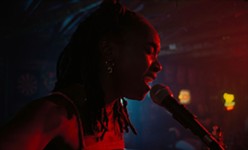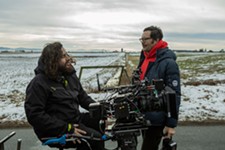Slamdance Interview: Chris Jericho Takes The Death Tour
Wrestling GOAT on his new role as documentarian
By Richard Whittaker, 5:53PM, Sun. Jan. 21, 2024

In professional wrestling circles, there have been two legendary trials of fire for any wannabe star: The Hart Dungeon, the legendary underground gym where Canadian wrestling icon Stu Hart would stretch and humble the most arrogant grapplers, and the Death Tour.
The roster of wrestlers who have taken the tour early in their career is a who’s who of industry greats: multi-time New Japan Pro Wrestling and AEW champ Kenny Omega; technical genius Lance Storm; hall of famers and legendary tag team partners Adam Copeland and Christian Cage; and a contender for the greatest wrestler of all time, Chris Jericho, who produced and appears in The Death Tour, Stephan Peterson and co-director Sonya Ballantyne’s documentary debuting at this year’s Slamdance Film Festival.
In the depths of winter, promoter Tony Condello fills a van with rising talent and then takes them on a tour of Inuit communities in the Northern Provinces, places besieged by poverty and isolation, communities plagued by violence and suicide, ignored by the outside world. It’s also legendarily brutal for the wrestlers: freezing temperatures, deadly roads (which more often than not are frozen lakes), and grinding remoteness, all amplified by spending a month with a pack of strangers, taking agonizing bumps and sleeping wherever you can.
Indeed, Jericho is a true rarity. Aside from having held titles in major promotions in America, Canada, Mexico, and Japan, he’s also a graduate of both the Death Tour and the Hart Dungeon. So which was tougher? “They’re two separate things, man,” he said. “The Hart Dungeon is months and months and months, but the Death Tour is weeks and weeks and weeks. You go to the Dungeon to hopefully get on a Death Tour and end up wrestling around the world.”
Working the tour was a major early step in Jericho’s career, one that lead him to headlining the WWE’s annual Wrestlemania megashow and selling out the Tokyo Dome. Additionally, he’s become a broadcaster, with his SiriusXM show Talk Is Jericho, entered the film business (most recently appearing in underground horror smash Terrifier 2), and achieved a second strand of celebrity as the vocalist of heavy metal band Fozzy. It was those last two interests that combined in his first producer credit, for 2021 documentary I'm Too Old for This Sh*t: A Heavy Metal Fairy Tale, following the surprise cult following of rock band Siren three decades after they’d split up. “I sent a camera crew to follow them around Europe, and the film did well from a creative standpoint, and when this documentary came across the proverbial desk, I thought, ‘well, it’s the second step for me to a documentarian.’”
Much like being an independent documentarian, no one does the Death Tour to get rich. Quite the opposite, as the wrestlers contend with the inflated expense of essentials in remote communities that can barely pay them to perform. It’s just one of the grueling hardships depicted in The Death Tour. Looking back on his own experiences, Jericho recalled, “You do this journey of three weeks across the frozen tundra. You travel for hours and hours and hours to get to a high school gym, to set up the ring, to do the show, to finish the show, to take down the ring, to sleep on the floor, and spend 50 bucks on a ham sandwich. That’s called paying your dues, and that’s what it takes to get to the next level in wrestling.”
Showing the struggles of life on the indie circuit is exactly why Jericho became involved in the project. “A lot of people don’t understand what it takes to be in the wrestling business, especially when you’re starting out,” he explained. “I wanted to show that struggle of being an independent wrestler where the Death Tour is everything.”
It’s also his way of paying tribute to Condello, who still goes out on the road, busting his own ass as much as he does any of the wrestlers, and bringing a night of joy to these forgotten communities. “We all owe him quite a bit,” he said. “You’re talking about Chris Jericho and Adam Copeland and Christian Cage and Doctor Luther and Rhyno and Don Callis and Kenny Omega – the list goes on and on.”
And making a documentary is, in some ways, a little like wrestling. You can have an idea what you want to do, of the kind of story you want to tell, when you get in the ring or get behind the camera. But like the saying goes, everyone has a plan until they get punched in the face. “That’s what I love about doing documentaries,” Jericho said. “You’re really live without a net. You don’t know what you’re gonna get when you set out with a camera crew to film whatever event you’re filming. That’s the fun of it. ‘Well, let’s see what happens.’”
The Death Tour screens as part of the Slamdance Film Festival.
A note to readers: Bold and uncensored, The Austin Chronicle has been Austin’s independent news source for over 40 years, expressing the community’s political and environmental concerns and supporting its active cultural scene. Now more than ever, we need your support to continue supplying Austin with independent, free press. If real news is important to you, please consider making a donation of $5, $10 or whatever you can afford, to help keep our journalism on stands.
July 12, 2024
July 12, 2024
Slamdance 2024, Slamdance Film Festival, Chris Jericho, AEW, The Death Tour, All Elite Wrestling








